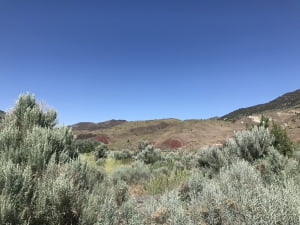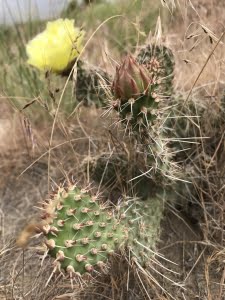
The Land of Milkvetch and Honey bees
--By Nadav Mouallem
For the ninth week of our Native Plant Society of Oregon internship (June 5-9), the Conservation Research field crew traveled to Vale, OR, to monitor Astragalus mulfordiae (we refer to it as ASMU), or Mulford’s milkvetch. Although we were already a seasoned field crew at this point, this trip was like no other. Unlike our previous trips to southwestern Oregon and the coast, this trip took us 370 miles east of Corvallis. We wound our way along Hwy 20, with Three Fingered Jack to our north and Mt. Washington to our south, through the Cascades, and into the heart of Oregon. The drive was astonishing, as we all witnessed the physical transformation of the landscape as we traveled further and further east. And as we snaked our way along the John Day River, through the steep canyons of the John Day Hwy towards Vale, it truly felt like a ‘journey through time.’
In the car ride we had ample time to discuss and prepare for our week - we familiarized ourselves with the morphology and phenology of Mulford’s milkvetch and the tasks that lay ahead of us. And as the sun began to set, we finally arrived at the Bully Creek Reservoir Campground on the outskirts of Vale, OR.
IAE has been studying the effects of ungulate (domestic sheep and cattle, as well as deer) grazing on Mulford’s milkvetch since 2008. Mulford’s milkvetch is a threatened, perennial herb native to eastern Oregon and Idaho that inhabits the arid and sandy soils of the Owyhee Uplands. Some of the major threats to ASMU include livestock grazing, mining, OHV use, and competition with invasive grasses - and as we drove to each of our sites, through fields of grazing cattle and onto hillsides covered in Bromus tectorum (cheatgrass) and winding OHV trails, these threats became a reality to us. At each of the eight sites we monitored caged (covered with wire to prevent grazing) and uncaged plots containing Mulford’s milkvetch to look more closely at the effects of ungulate grazing in addition to monitoring transects to examine changes in plant community and ground disturbance since 2008.


Our week in Vale was filled with unique plant and animal species. Some my favorites were the Kangaroo rat, a small rodent with huge hops that inhabited a hole along one of our transects, and the Long-billed Curlew, America’s largest shore bird that spends its summer months in the grasslands of the western US. Some of my favorite plants were Wyoming big sagebrush (Artemisia tridentata ssp. wyomingensis), an aromatic shrub found in arid Oregon, and plains pricklypear (Opuntia polyacantha), a cactus native to the region that has haunted our crew leader’s dreams since she knelt in one last year. Proving that field work isn't for the faint of heart, other frightening sightings included a black widow spider, gopher snakes, and swarming honey bees!




Restoration
Research
Education
Get Involved
Contact
Main Office:
4950 SW Hout Street
Corvallis, OR 97333-9598
541-753-3099
[email protected]
Southwest Office:
1202 Parkway Dr. Suite B
Santa Fe, NM 87507
(505) 490-4910
[email protected]
© 2024 Institute for Applied Ecology | Privacy Policy
